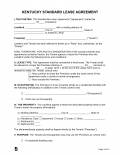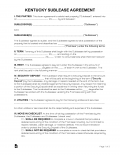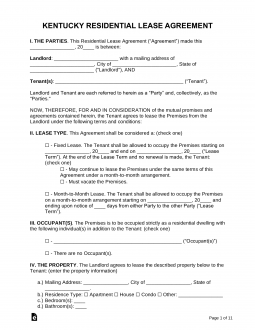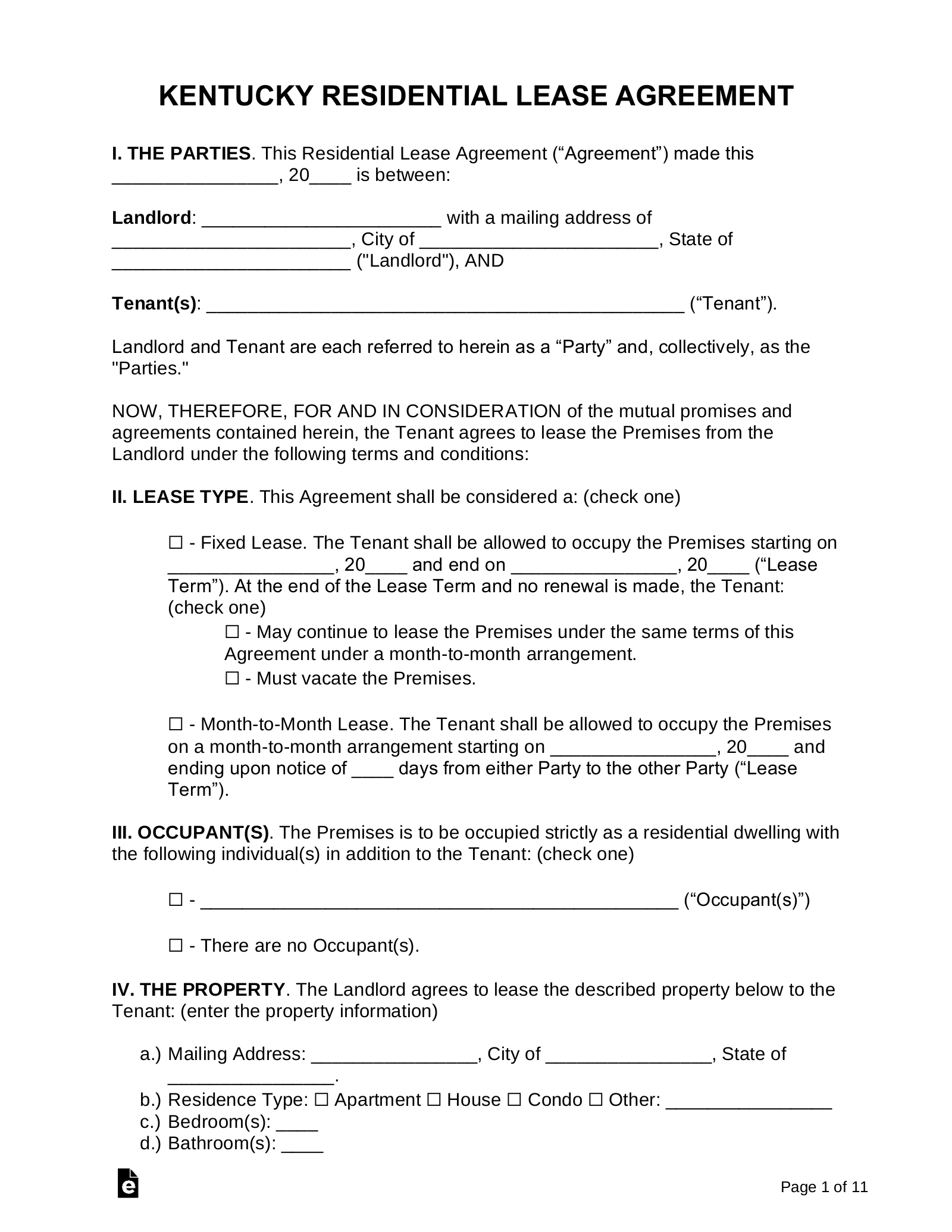Updated November 21, 2023
A Kentucky rental contract is a document used for the leasing of residential or commercial property between a landlord and a paying tenant. After the tenant has viewed the property, they will typically have to complete a rental application so the landlord can view their employment, credit, and background information. Once the tenant is approved, a lease should be drafted that includes the negotiated terms of both parties.
Table of Contents |
Agreement Types (7)
 Standard Residential Lease Agreement – Establishes a tenancy arrangement in which a landlord leases property to a tenant for a fixed term. Standard Residential Lease Agreement – Establishes a tenancy arrangement in which a landlord leases property to a tenant for a fixed term.
Download: PDF, MS Word, OpenDocument |
 Commercial Lease Agreement – Space that is used for business-related use. Commercial Lease Agreement – Space that is used for business-related use.
Download: PDF, MS Word, OpenDocument |
 Month-to-Month Lease Agreement – A rental arrangement that has no end date but allows either party to terminate the contract with at least 30 days’ notice. Month-to-Month Lease Agreement – A rental arrangement that has no end date but allows either party to terminate the contract with at least 30 days’ notice.
Download: PDF, MS Word, OpenDocument |
 Real Estate Commission (KREC) Lease Agreement – A recommended sample lease provided by the State of Kentucky. Real Estate Commission (KREC) Lease Agreement – A recommended sample lease provided by the State of Kentucky.
Download: PDF |
 Rent-to-Own Lease Agreement – Standard contract for the renting of residential property with the added choice of being able to buy the premises. Rent-to-Own Lease Agreement – Standard contract for the renting of residential property with the added choice of being able to buy the premises.
Download: PDF, MS Word, OpenDocument |
 Room Rental (Roommate) Agreement – Contract between individuals sharing a housing situation wherein each person has their own room with shared responsibility for the common areas. Room Rental (Roommate) Agreement – Contract between individuals sharing a housing situation wherein each person has their own room with shared responsibility for the common areas.
Download: PDF, MS Word, OpenDocument |
 Sublease Agreement – For a tenant that is seeking another person to take over space they are leasing from a landlord in order to move elsewhere or take away the burden of payment. Sublease Agreement – For a tenant that is seeking another person to take over space they are leasing from a landlord in order to move elsewhere or take away the burden of payment.
Download: PDF, MS Word, OpenDocument |
Required Disclosures (4)
- Authorized Access – The landlord must describe and mention in the lease individuals allowed onto the property, such as managers, agents, etc.[1]
- Lead-Based Paint Disclosure – A law created by the Federal Environmental Protection Agency (EPA) that requires the landlord to provide notice to the tenant about the paint on the property’s interior. Only required for buildings constructed prior to 1978.
- Move-In Inspection Form – If a security deposit is accepted, the landlord is required to report the pre-existing damage on the property. The tenant should verify the report and sign it.[2]
- Security Deposit Receipt – If a security deposit is accepted, the landlord must state where the deposit is being held and include the bank’s account number.[3]
Security Deposits
Maximum Amount – There is no limit on how much the landlord may ask from the tenant when authorizing the lease.
Collecting Interest – The landlord is not required to collect interest on the security deposit on behalf of the tenant.
Returning to Tenant – The landlord must return the deposit within 60 days from the termination date if the tenant owes no rent and a refund applies. If the tenant does not give the landlord a forwarding address within the said time frame, they may keep the funds.[4]
- Itemized List – The landlord is required to provide a comprehensive list of any damages to the unit and the estimated cost of repair as the basis for the deductions made on the security deposit. The tenant has the right to inspect the premises to ascertain the accuracy of the list and either sign off or make a dispute.[5]
When is Rent Due?
Grace Period – Rent is due on the date mentioned in the lease. There is no grace period for tenants, the landlord can charge a penalty and give the notice to quit on the next day (if rent is unpaid).
Maximum Late Fee – $20 or 20% of the rent amount may be charged to the tenant if rent is late, whichever is greater. The late fee must be mentioned in the lease.[6]
NSF Fee – The maximum allowable fee is $50 a landlord may charge for a bad check.[7]
Withholding Rent – The tenant may withhold or deduct from their rent payment if the landlord willfully fails to provide essential services, such as running water or heat.[8]
Right to Enter (Landlord)
Standard Access – The landlord must give at least two days’ notice to the tenant before entering the premises for any non-emergency reason.[9]
Immediate Access – The landlord may enter the unit without providing notice in the case of an emergency.[10]
Abandonment
Absence – The tenant must notify the landlord if they will be absent from the unit for seven days or more.[11] If the tenant fails to do so, the landlord may recover damages from the tenant and enter the premises without notice.[12]
Breaking the Lease – If the tenant abandons the unit before the lease expires, the landlord must make a reasonable effort to rent the property to someone else. The damages collected from the tenant would be for the period up to the date of the new tenancy, not the original lease end date.[13]
Tenant’s Utility Shutoff – There are no laws requiring the tenant to maintain utility services. However, the tenant must maintain the property for the health and safety of its occupants, including the reasonable use of facilities.[14]
Unclaimed Property – There are no laws dictating how the landlord must handle a tenant’s abandoned property.
Sources
- Ky. Rev. Stat. § 383.585
- Ky. Rev. Stat. § 383.580(2)
- Ky. Rev. Stat. § 383.580(1)
- Ky. Rev. Stat. § 383.580(7)
- Ky. Rev. Stat. § 383.580(3)
- Ky. Rev. Stat. § 359.215(3)
- Ky. Rev. Stat. § 514.040(4)(b)
- Ky. Rev. Stat. § 383.640(1)
- Ky. Rev. Stat. § 383.615(3)
- Ky. Rev. Stat. § 383.615(2)
- Ky. Rev. Stat. § 383.670(1)
- Ky. Rev. Stat. § 383.670(2)
- Ky. Rev. Stat. § 383.670(3)
- Ky. Rev. Stat. 383.605(5)


